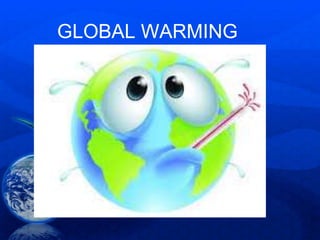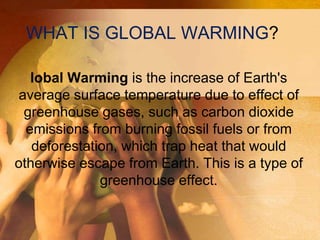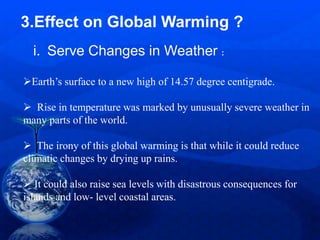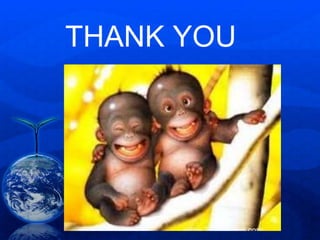global warming
- 2. WHAT IS GLOBAL WARMING? lobal Warming is the increase of Earth's average surface temperature due to effect of greenhouse gases, such as carbon dioxide emissions from burning fossil fuels or from deforestation, which trap heat that would otherwise escape from Earth. This is a type of greenhouse effect.
- 3. 2.What is GREENHOUSE EFFECT ? Gas in the atmosphere, such a water, carbon dioxide, methane, CFCs and nitrous oxide, absorb infrared light and would otherwise escape to space, radiating it back towards the planet’s surface. These gases are called ‘ greenhouse gases’ and they have a critical role in determining the temperature of the Earth’s surface and the living conditions on the planet. This natural process is called the “greenhouse effect”.
- 4. 3.Effect on Global Warming ? Earth’s surface to a new high of 14.57 degree centigrade. Rise in temperature was marked by unusually severe weather in many parts of the world. The irony of this global warming is that while it could reduce climatic changes by drying up rains. It could also raise sea levels with disastrous consequences for islands and low- level coastal areas. i. Serve Changes in Weather :
- 5. II.Impact on Arctic Ecosystem :- The ecosystem which sustains the livelihood of Arctic residents is melting the ice as temperature rise. The layer of permafrost is melting, causing an inland lake to drain into the ocean and killing fresh water fish.
- 7. iii.Kyoto Protocol :- A un- brokered treaty was signed by in 1997 in Kyoto Japan. It was called the Kyoto Protocol. It commits the rich countries to binding cut in their emission of greenhouse gases, such as carbon dioxide. The developed countries agreed to cut their emissions by a collective average of 5 percent below their levels in 1990 by 2008-2012. Representative Climate Conference (COPC) in Nov 2000, and discussed about the implementation of the Kyoto Protocol.
- 8. iv. Erratic Rain :- People around the world will experience climate changes and the erratic rainfall China to Africa will jeopardize the lives of many people. IT is now nearly a decade since the IPCC accepted that human activates were changing the world’s climate. The most severe warming is seen in the Arctic were the ice pack is shrinking, and thinning, according to the US experts.
- 9. v.More storms, foods, droughts, submergence of islands :- Scientists have warned that a warmer world will mean more storms, floods, droughts, and snowfalls. The countries that have to suffer most if the Hague talks fail are the small countries. Islands in danger of being submerged, from the Pacific to the Caribbean are panicky. The lives of
- 10. vi. Ozone Getting Depleted :- Pollution from transport is the fastest growing source of carbon dioxide emissions since the industrial revolutions Carbon emission levels responsible for 70 percent of global warming vary widely among nations. Due to these emissions the ozone layer that provides a protective shield over the Earth from the harmful ultravoilent radiation is getting depleted. Another greenhouse gas, methane, has more than doubled. RESULT OF THIS, VERY HOT WEATHER LIKE THE SAME IN DESERT REGION OR MORE THAN
- 11. vii.Major Climate Change :- If we do not act to reduce the emission of these heat- trapping gases, it is predicted that global temperature could rise 2 degree to 6degree Fahrenheit in the next 100 yrs. Just a few degree difference in the global average temperature can mean a major climate change. The amt o greenhouse gases that are released could be controlled through prudent planning and implementation of environmental priorities. Man has to act now to insure against the risk of destructive future warming by reducing the greenhouse gas emissions.
- 12. THE CHANGES IF GLOBAL WARMING WILL NOT BE REDUCED
- 14. THANK YOU













